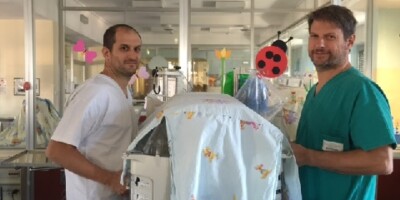Model-Base Estimation of Non-Invasive Ventilation Weaning of Preterm Infants Exposed to Osteopathic Manipulative Treatment: A Propensity-Score-Matched Cohort Study
Autori
Andrea Gianmaria Tarantino, Luca Vismara, Francesca Buffone, Giuliana Bianchi, Andrea Bergna, Monica Vanoni, Claudia Tabbi, Ilia Bresesti, Massimo Agosti
Abstract
ABSTRACT
Ventilation weaning is a key intensive care event influencing preterm infants’ discharge from a neonatal intensive care unit (NICU). Osteopathic manipulative treatment (OMT) has been recently introduced in some Italian NICUs. This retrospective cohort study tested if OMT is associated with faster non-invasive ventilation (NIV) weaning. The time to NIV weaning was assessed in very preterm and very low birth weight infants who either received or did not receive OMT. The propensity score model included gender, antenatal steroids, gestational age (GA), birth weight (BW), and Apgar score 5′. Out of 93 infants, 40 were included in the multilevel survival analysis, showing a reduction of time to NIV weaning for GA (HR: 2.58, 95%CI: 3.91 to 1.71, p p = 0.002). Time to independent ventilation (TIV) was modeled with GA and BW as dependent variables and OMT as the factor. A negative linear effect of GA and BW on TIV was shown. OMT exposure studied as the factor of GA had effects on TIV in infants born up to the 32nd gestational week. Preterm infants exposed to OMT were associated with earlier achievement of NIV weaning. This result, together with the demonstrated OMT safety, suggests the conduct of clinical trials in preterm infants younger than 32 weeks of GA.
INTRODUCTION
Very preterm infants often need positive pressure ventilatory support due to the immaturity of their chest wall pulmonary system; the reduced quantity and quality of surfactant; the neurological and thoracoabdominal asynchrony; the weakness of the intercostal muscles; and the relative shape and position of the diaphragm affecting ventilation, causing atelectasis and subsequently the tendency of the lungs to collapse. To prevent respiratory failure, respiratory distress syndrome (RDS), and bronchopulmonary dysplasia (BPD), preterm infants often require the support of non-invasive ventilation (NIV) [1,2,3,4,5,6,7].
However, even though respiratory support is fundamental during intensive care, recent studies showed that a too-long period—either of invasive ventilation or non-invasive ventilation—is associated with an increased risk of mortality or neurodevelopmental disability, due to the hemodynamic instability and cerebral inflammatory response [8,9]. Therefore, any therapy combined with NIV that can enhance the infants’ adaptation and cardiorespiratory function—consequently reducing the time of ventilation—would have a significant impact on morbidity and mortality. Moreover, since the accomplishment of an autonomous and stable cardiorespiratory function is one of the criteria for discharge [10,11], it would also have a positive influence on human costs and expenses of the health system (only for extremely preterm infants is there a mean cost of USD 65,600) [12,13,14,15,16,17].
The osteopathic manipulative treatment (OMT) is a non-invasive complementary manual therapy that enhances the functional integrity of the body, improves the physiological function, and supports homeostasis [18,19]; it evaluates and treats the somatic dysfunction (SD), which is defined as “an impaired or altered function of related components of the body framework system: skeletal, arthrodial, and myofascial structures, and their related vascular, lymphatic, and neural elements” [20,21]. Different studies have evaluated its possible contributions in the pediatric field, looking especially at prematurity: for instance, OMT is related to reduced timing to oral feeding, shorter LOS, and improvements in cardiac frequency and oxygen saturation [22,23,24,25,26,27,28]. Moreover, a recent study described the correlation of SD severity assessed with the Variability Model and the vagal tone in preterm infants [29]. In this perspective, the OMT added to the standard therapies may play a fundamental role in the short-term effects during the stay in the neonatal intensive care unit (NICU) and in the medium- and long-term effects for the prevention of respiratory diseases.
The main aim of this propensity-score-matched retrospective cohort study is to understand if the OMT is associated with faster NIV weaning; as secondary aims, it was assessed if the OMT is also associated with LOS, anthropometric growth, and time to autonomous respiration.
RESULTS:
Out of 94 screened infants, 20 infants per group were eligible and were included via the propensity score matching. At baseline, there was homogeneity for the main variables in the two groups, and the propensity score efficacy was tested with the standardized mean difference (SMD). Concerning the diseases, both groups mainly reported RDS, followed by PDA, apneas, and BPD. Instead, the prevalent type of NIV was nasal high-frequency oscillatory ventilation (NHFOV), followed by NCPAP. On average, a TIV difference of 9.85 (−0.93 to 20.62) days was registered between groups combined with a difference of 5.34 (−10.07 to 21.98) days of LOS, which was lower in the exposed group, although non-statistically significant.
KEYWORDS: Osteopathic manipulative treatment, neonatal intensive care unit, non-invasive ventilation weaning, preterm infants
ID: 3774957





